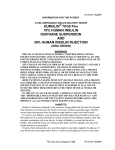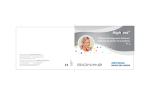Transcript
17.Limitations 1.No Neonatal use Do not use for neonatal blood glucose testing. 2.Hematocrit range Hematocrit in the range of 32~60% has been shown not to affect the glucose results. If you do not know your hematocrit level, consult your healthcare professional. 3.Hemoglobin range Hemoglobin levels of 0.078 mmol/L (500 mg/dL) did not interfere with blood glucose test results. 4.Elevated Cholesterol and Triglycerides Cholesterol levels up to 12.9 mmol/L (500 mg/dL) and Triglycerides up to 33.1 mmol/L(1000 mg/dL) has been shown not to affect glucose results. 5.Medications Interference was observed for therapeutic levels of L-DOPA. No interference was shown for uric acid, acetaminophen, ascorbic acid and ibuprofen in normal therapeutic levels. However, higher concentrations in blood may cause incorrect results: Uric acid: > 0.65 mmol/L(10.9 mg/dL); acetaminophen: >0.41 mmol/L (6.2 mg/dL); ascorbic acid: >0.26 mmol/L(4.5 mg/dL); ibuprofen: >1.82 mmol/L(37.5 mg/dL). 6.The test strips may be used at altitudes up to 5,280 feet (1,609 m ) without an effect on test results. 7.Persons suffering from severe dehydration should not be tested using a capillary whole blood sample. 8.Test results below 3.9 mmol/L(70 mg/dL) indicate low blood glucose (hypoglycemia). Test results greater than 13.3 mmol/L (240 mg/dL) indicate high blood glucose (hyperglycemia). If you get results below 3.9 mmol/L(70 mg/dL)or above 13.3 mmol/L (240 mg/dL), repeat the test, and if the results are still below 3.9 mmol/L(70 mg/dL)or above 13.3 mmol/L(240 mg/dL), please 2 consult your healthcare professional immediately . 9.Inaccurate results may occur for individuals experiencing a hyperglycemic-hyperosmolar state, with or without ketosis. Critically ill patients should not be tested with a blood glucose meter. 29







